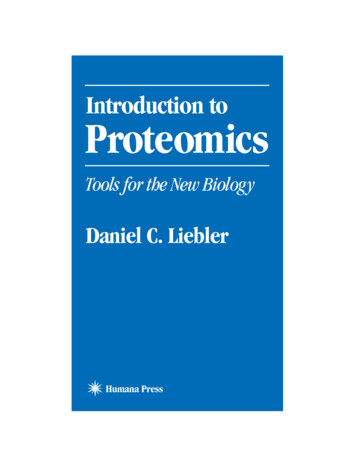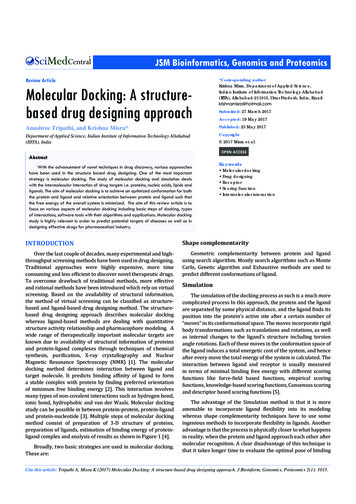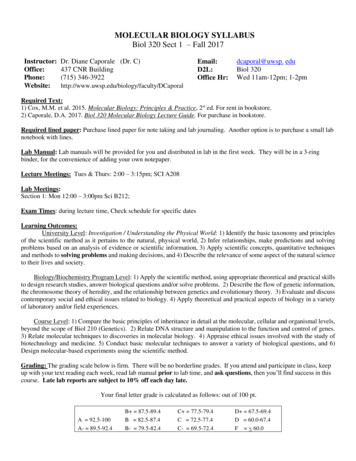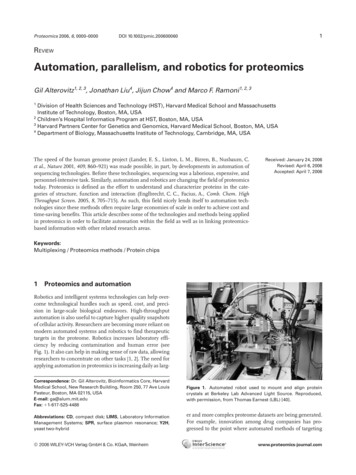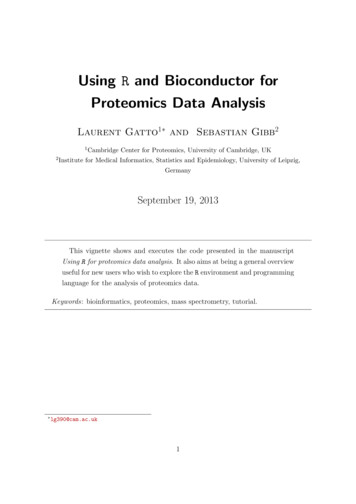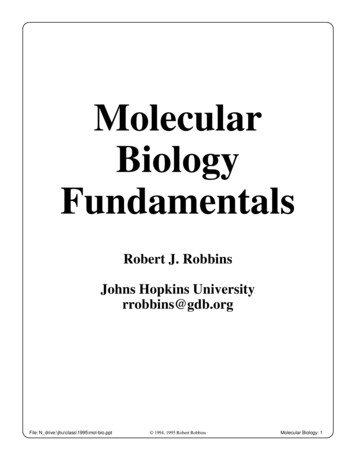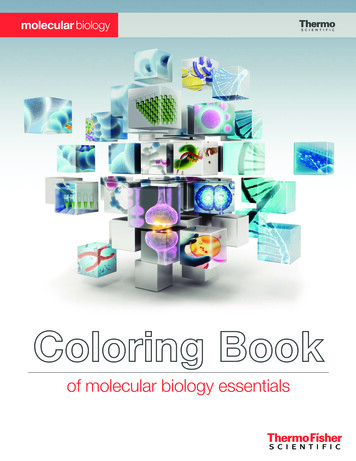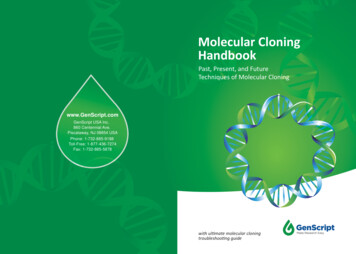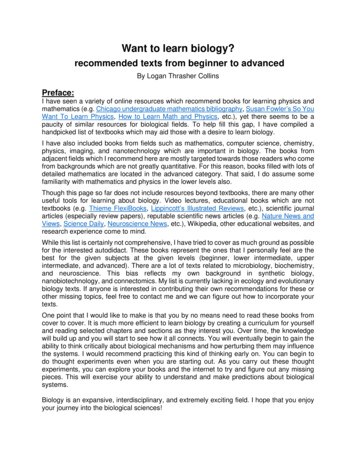
Transcription
Kariithi et al. Parasites & Vectors (2016) 9:424DOI 10.1186/s13071-016-1714-zRESEARCHOpen AccessA proteomics approach reveals molecularmanipulators of distinct cellular processesin the salivary glands of Glossina m.morsitans in response to Trypanosomab. brucei infectionsHenry M. Kariithi1,5*, Sjef Boeren2, Edwin K. Murungi3, Just M. Vlak4 and Adly M. M. Abd-Alla5*AbstractBackground: Glossina m. morsitans is the primary vector of the Trypanosoma brucei group, one of the causativeagents of African trypanosomoses. The parasites undergo metacyclogenesis, i.e. transformation into themammalian-infective metacyclic trypomastigote (MT) parasites, in the salivary glands (SGs) of the tsetse vector.Since the MT-parasites are largely uncultivable in vitro, information on the molecular processes that facilitatemetacyclogenesis is scanty.Methods: To bridge this knowledge gap, we employed tandem mass spectrometry to investigate proteinexpression modulations in parasitized (T. b. brucei-infected) and unparasitized SGs of G. m. morsitans. Weannotated the identified proteins into gene ontologies and mapped the up- and downregulated proteinswithin protein-protein interaction (PPI) networks.Results: We identified 361 host proteins, of which 76.6 % (n 276) and 22.3 % (n 81) were up- anddownregulated, respectively, in parasitized SGs compared to unparasitized SGs. Whilst 32 proteins weresignificantly upregulated ( 10-fold), only salivary secreted adenosine was significantly downregulated.Amongst the significantly upregulated proteins, there were proteins associated with blood feeding,immunity, cellular proliferation, homeostasis, cytoskeletal traffic and regulation of protein turnover. Thesignificantly upregulated proteins formed major hubs in the PPI network including key regulators of theRas/MAPK and Ca2 /cAMP signaling pathways, ubiquitin-proteasome system and mitochondrial respiratorychain. Moreover, we identified 158 trypanosome-specific proteins, notable of which were proteins in thefamilies of the GPI-anchored surface glycoproteins, kinetoplastid calpains, peroxiredoxins, retrotransposonhost spot multigene and molecular chaperones. Whilst immune-related trypanosome proteins wereover-represented, membrane transporters and proteins involved in translation repression(e.g. ribosomal proteins) were under-represented, potentially reminiscent of the growth-arrestedMT-parasites.(Continued on next page)* Correspondence: henry.kariithi@kalro.org; a.m.m.abd-alla@iaea.org1Biotechnology Research Institute, Kenya Agricultural and Livestock ResearchOrganization, P.O Box 5781100200Kaptagat Rd, Loresho, Nairobi, Kenya5Insect Pest Control Laboratories, Joint FAO/IAEA Division of NuclearTechniques in Food and Agriculture, International Atomic Energy Agency,Wagrammer Straße 5, Vienna, AustriaFull list of author information is available at the end of the article 2016 The Author(s). Open Access This article is distributed under the terms of the Creative Commons Attribution 4.0International License (http://creativecommons.org/licenses/by/4.0/), which permits unrestricted use, distribution, andreproduction in any medium, provided you give appropriate credit to the original author(s) and the source, provide a link tothe Creative Commons license, and indicate if changes were made. The Creative Commons Public Domain Dedication o/1.0/) applies to the data made available in this article, unless otherwise stated.
Kariithi et al. Parasites & Vectors (2016) 9:424Page 2 of 19(Continued from previous page)Conclusions: Our data implicate the significantly upregulated proteins as manipulators of diverse cellularprocesses in response to T. b. brucei infection, potentially to prepare the MT-parasites for invasion andevasion of the mammalian host immune defences. We discuss potential strategies to exploit our findingsin enhancement of trypanosome refractoriness or reduce the vector competence of the tsetse vector.Keywords: LC-MS/MS, Protein-protein interaction, Metacyclic trypomastigotes, Metacyclogenesis, Vectorcompetence, Trypanosome refractorinessBackgroundTrypanosoma brucei group causes African trypanosomoses, a group of neglected zoonotic tropical diseasesendemic in 37 sub-Saharan African countries [1], againstwhich there are no effective vaccines or drugs [2, 3].Amongst the medically and agriculturally important tsetsefly species, Glossina morsitans morsitans is highly significant in the savannah woodlands and is the primary vectorof the species of T. brucei group [4].In order to complete their complex developmentalcycles in the tsetse vector, trypanosomes face two criticalreplicative stage barriers: colonization of the midguts andestablishment in the salivary glands (SGs). The pathwayfollowed by the parasites between these two independentmulti-replicative stages is time-dependent, irreversiblytransient and eventually influences metacyclogenesis inthe SGs (differentiation into the mammalian-infectivemetacyclic trypomastigote (MT) parasites) [5–9]. Criticalreplicative events occur 3 days post-infective blood mealwhen only a small proportion ( 10 %) of the parasites isable to pass through the midgut barrier [8]. Upon establishment of infection, parasite numbers per fly gutremain remarkably constant [6, 8]. However, since the SGderived MT-parasites are uncultivable in vitro, molecularmechanisms that promote metacyclogenesis remain to beinvestigated.Whilst the SGs determine success of metacyclogenesis,there is limited knowledge on how trypanosomes adaptto and evade the host defence responses in the SGs [10].It is however generally known that trypanosomes modulate SGs microenvironment [11], and that factors suchas parasite genotypes, midgut antioxidant status, lectinsand environmental stimuli influence parasite maturation[12, 13]. Most trypanosome research has focussed on thebloodstream and/or in vitro cultured procyclic forms, thuscreating a knowledge gap with regard to metacyclogenesis.The availability of complete genomes of G. morsitans [14]and T. brucei [15] makes it possible to identify proteinsinvolved in the mechanisms that facilitate metacyclogenesis. Such proteins are ideal candidates to developimproved strategies for tsetse and trypanosomosis control,especially via the sterile insect technique (SIT) programs[16], which have so far been employed in areas withoutactive disease transmission [2].Vector competence is one of the key pillars in the SITprograms, which involves mass release of sterile malesinto wild populations of the target species. More importantly, the sexually sterilized males are still competenttrypanosome vectors, thus increasing risks of diseasetransmission when millions of sterile males are releasedinto trypanosome-infested areas. Attempts have beenpreviously made to make the sterile males vector incompetent via drug-supplemented blood meals, an approachnow known to be inefficient [17]. Thus, alternative and/or complementary approaches are necessary, especiallywith the risk of trypanosomes developing resistance tothe trypanocidal drug supplements. In this regard, metacyclogenesis and transmission of the mammalian-infectiveMT-parasites potentially represent vulnerable and attractive intervention points to enhance the natural trypanosome refractoriness or reduce the vectorial competence ofthe sterile males used in the SIT campaigns.We hypothesized that T. b. brucei manipulates expressionof proteins involved in pathways that specifically preparethe MT-parasites for successful transmission to and infection of susceptible mammalian hosts. To test this hypothesis, we employed tandem mass spectrometry (LC-MS/MS)to determine T. b. brucei-induced protein expression modulations in parasitized SGs of G. m. morsitans compared tounparasitized SGs. We also aimed at highlighting majormetacyclic T. b. brucei-specific proteins, which are potentially critical for parasite survival in the SGs and transmission to susceptible mammalian hosts. We discuss ourfindings from the perspective of potential approaches to enhance trypanosome refractoriness in tsetse as an antivector strategy against African trypanosomosis.MethodsTsetse flies and parasites infectionsMale G. m. morsitans were obtained from the Institute ofTropical Medicine (Antwerp, Belgium) and infected witha highly transmissible T. b. brucei strain (EATRO 1125AnTaR 1) [11]. Male flies were used because they maturesignificantly more midgut infections than females [5]. Forthe infections, teneral flies (24–48 h post-adult eclosion)received their first blood meals supplemented with 12 μgof parasites/fly [11]. Fully-engorged flies were selected,reared for 28 days post-infection (dpi) in controlled
Kariithi et al. Parasites & Vectors (2016) 9:424insectaria (65 % relative humidity; 26 C) and subsequentlyfed on clean (trypanosome-free) defibrinated horse blood(in vitro; 2–3 times/week) [18]. Control flies were preparedfrom males of the same batch, age and feeding history asthe parasitized flies. The control flies were maintained onclean blood meals and handled as described for theirparasitized counterparts. All assays consisted of biologicaltriplicates (20 flies per group) in small holding cells(3.5 cm in diameter 6 cm height).Parasite scoring and SG dissectionsForty-eight h after the last blood meal, the flies werescored for the presence of the MT-parasites in the SGsusing phase-contrast microscopy ( 400) as previouslydescribed [11]. Briefly, the SGs were considered parasitized if stuffed with trypanosomes (i.e. the fly’s spit fullof the parasites). Fly’s spit (from the control group)completely devoid of trypanosomes were consideredunparasitized. For mass spectrometry, 10 intact pairs ofSGs were selected from each of the replicated fly groupsand immediately preserved at -20 C in 150 μl sterilesaline supplemented with complete protease inhibitorcocktail (Roche Diagnostics, Mannheim, Germany).SG extracts preparation and SDS-PAGESGs were individually homogenized using a glass/Teflonhomogenizer and ultra-sonicated (Sonifier cell disruptor,Branson Instruments Co., Stanford, Connecticut, USA).Homogenates were freeze-thawed and clarified threetimes by centrifugation (7500 g; 10 min; 4 C) to completely remove cell debris. Supernatants were pooledand proteins quantified using the standard BCA method(Bio-Rad, Hercules, California, USA). Equal protein quantities (600 ng) were resolved in 12 % SDS-PAGE gels andstained (CBB stain; NuPAGE Novex; Invitrogen LifeTechnologies, Carlsbad, California, USA). The middlesections of entire gel lanes were longitudinally excised(from top to bottom), divided into five equal fractions(covering the entire gel lanes) and cut into small pieces( 1 mm3) as previously described [19].LC-MS/MS measurements and protein identificationTryptic peptides for subsequent LC-MS/MS measurements were prepared as previously described [19]. Briefly,the gel pieces were washed with 50 mM ammoniumbicarbonate (ABC) buffer and ABC buffer/50 % acetonitrile(ACN) and proteins reduced and alkylated using dithiothreitol and iodoacetamide. Gels were washed with ABC/ABC-ACN buffer, followed by in-gel trypsin digestions andLC-MS/MS measurements [20]. Proteins were identifiedby searching the MS/MS spectra (using MaxQuant/Andromeda [21, 22]) against G. m. morsitans and T. bruceidatabases (downloaded from UniProt), a decoy database(constructed by reversing all the protein sequences) and aPage 3 of 19database of common contaminants (available from MaxQuant). MaxQuant search parameters included fixed carbamidomethylation (C), oxidation (M), acetylation anddeamidation (N and Q). Two peptides (at least oneunique and unmodified) matching the same protein wererequired for protein identification at a maximum false discovery rate (FDR) of 0.01. The unique identifiers of theproteins downloaded from the UniProt databases wereused to identify and classify the LC-MS/MS peptides asspecific to the host (G. m. morsitans) and the parasite (T.b. brucei). LC-MS/MS peptide hits to the decoy databaseand hits with modified peptides only were deleted fromthe final list of protein groups.Protein quantification and normalizationUnique and ‘razor’ (non-unique) peptides were used forpeptide assignments and protein quantification [21, 23].For each of the above-described five gel fractions, peptideswere matched across different MS/MS runs based onmass and retention time (‘match between runs’ of 2 min).Label-free quantification (LFQ) was enabled. To minimizetechnical variations and to easily compare abundances ofthe same proteins (parasitized vs unparasitized), Log10normalized LFQ was used across the biological triplicates.To compare levels of different proteins from the samesamples (parasitized and unparasitized), Log10 iBAQ(intensity-based absolute quantitation) was used [24]. Todetermine up- and downregulated proteins (parasitized vsunparasitized SGs), t-tests were performed on Log10 LFQusing the MaxQuant’s Perseus module. Proteins wereconsidered to be up- or downregulated when their Log10iBAQ ratios (parasitized vs unparasitized) were larger orsmaller than zero, respectively, and significantly upregulated when the FDR was 0.05.Gene ontology (GO) annotations and PPI networkanalyses of upregulated SG proteinsBlast2GO v. 3.2 [25] was used to classify the identifiedproteins along three biological aspects, i.e. biologicalprocess (BP), molecular function (MF) and cellular component (CC) Gene Ontology (GO) terms. It should benoted that the GO terms are descriptions of the differentprotein functional classes and how they relate to eachother. To provide a broader overview of the ontologies,the GO classes were grouped into GO-slim terms usingCateGOrizer [26]. To correctly place the significantly upregulated proteins within signaling pathways and networks, computational predictions of protein-proteininteractions (PPIs) were inferred using interolog mapping[27]. For this, human orthologs to the identified G. m.morsitans proteins were obtained from Ensembl [28] andused to generate an exhaustive list of possible interactingprotein combinations using custom in-house Pythonscripts. Putative interactions for these combinations were
Kariithi et al. Parasites & Vectors (2016) 9:424then determined using FpClass [29] (probability 0.2) andmapped back onto the SG protein datasets obtained fromthe above-mentioned LC-MS/MS measurements. Theresulting significant interactome was rendered in Cytoscape v3.30 [30].ResultsParasitized SG proteome of G. m. morsitansAnalysis of the LC-MS/MS data resulted in 5469 and4366 total and unique peptides, respectively. These peptides mapped to 874 protein groups. Removal of thecommon contaminants, applying extra filter steps suchas removing single peptide hits (thereby decreasing FDRto below 0.01) and hits to the decoy database resulted in523 non-redundant (nr) protein groups (Additional file1: Table S1). Of these, 363 protein groups had specificpeptide hits to the tsetse vector (G. m. morsitans) proteins(Additional file 1: Table S2) and 158 protein groups hadspecific peptide hits to the parasite (T. b. brucei) proteins(Additional file 1: Table S3). We also obtained peptide hitsto four proteins specific to the bacterial endosymbiontsWigglesworthia glossinidia (n 3) and Sodalis glossinidius(n 1) (Additional file 1: Table S4). These symbiontPage 4 of 19proteins have been reported in the genome of G. m.morsitans [14]. It should be noted that there were no hostand/or parasite and/or symbiont proteins that groupedtogether in one protein group. Figure 1 shows the abundance distribution of the proteins identified in parasitizedSGs compared to unparasitized SGs.Table 1 presents the topmost abundant 25 proteins,amongst which were the following blood feeding-associatedproteins: tsetse salivary gland proteins-1 & 2 (Tsal1/2),tsetse salivary growth factors-1 & 2 (TSGF-1/2), salivaryantigen-5-protein (TAg5), 5′-nucleotidase-related salivaprotein (5′Nuc), adenine deaminase (ADA) and 5′-nucleotidase-related SG protein-3 (Sgp3). Also abundant wereproteins related to cellular proliferation/differentiation(adenosine deaminase-related growth factors, muscle LIMprotein at 84B), cytoskeletal proteins of the actin andmyosin families, lectins, molecular chaperones (e.g. 143-3 protein zeta family chaperones) and enzymes (e.g.trehalose-6-phosphate synthase, isovaleryl-CoA dehydrogenase, and aspartate aminotransferase).Amongst the least abundant proteins that we identified included dihydrolipoamide transacylase α-ketoaciddehydrogenase (DBT) complex proteins (for amino acidFig. 1 Distribution of proteins in parasitized G. m. morsitans SG proteome. Scatter plot distribution of the protein expression measurements forthe identified G. m. morsitans proteins (red; n 361), Trypanosoma proteins (green; n 158) and bacterial endosymbiont proteins (purple; n 4).Selections of the most notable proteins are named in the figure. See text for abbreviations
Kariithi et al. Parasites & Vectors (2016) 9:424Page 5 of 19Table 1 Annotations of the most abundant host proteins detected in Glossina m. morsitans SGs. Proteins are listed from the mostabundant in descending orderUniProtIDProtein nameMol. weight SequencePeptides Log10 iBAQ -Log t-test t-test ratios (infected Description/functional(kDa)coverage (%)(P-value)vs unparasitized)roles in insectsD3TMW5 Tsetse salivary glandprotein 243.95587.950 [2]9.482.67-0.53 ( )Blood-feeding; immunogenicD3TLK6Tsetse salivary glandgrowth factor-156.5978.966 [5]9.463.60-0.49 ( )Blood-feeding andanti-haemostasisD3TQL1Salivary antigen 5variant28.92578.432 [18]9.363.18-0.69 ( )Blood-feeding and otherextensive physiological rolesQ9NBA5Tsetse salivarygland protein 145.61387.045 [20]9.212.16-0.58 ( )Blood-feeding; ) saliva protein62.06467.237 [37]8.803.06-0.58 ( )Blood-feeding; downregulatedin parasitized fliesD3TQW4 Adenosinedeaminase-relatedgrowth factor C62.265.639 [32]8.731.96-0.38 ( )Cell proliferation;non-immunogenicQ9NBA4Tsetse salivary glandprotein 244.00184.548 [9]8.711.88-0.52 ( )Involved in blood-feeding;immunogenicD3TPT6Actin 87E41.83172.125 [1]8.650.210.10 ( )Overexpressed inhytrosavirus-infected tsetseD3TKU2Adenine deaminase24.1446.720 [2]8.483.01-0.47 ( )Blood-feeding; vectorcompetence; cellular proliferationD3TKU05′nucleotidase27.730 [30]8.451.42-0.44 ( )Blood-feeding; downregulatedin parasite-infected fliesQ9U7C5Tsetse salivary glandgrowth factor-258.22257.140 [40]8.402.09-0.54 ( )Blood-feeding 6263.316 [16]8.392.09-0.36 ( )Influence trypanosomeestablishment and maturationD3TPN5Arginine kinase40.02965.426 [25]8.041.050.19 ( )Abundantly expressed insilkworms; insect homeostasisQ9U7C6Tsetse salivary glandgrowth factor-156.63176.363 [2]8.020.44-0.24 ( )Blood-feeding andantihaemostasis;non-immunogenicD3TQC9Muscle LIM proteinat 84B10.07761.36 [1]7.901.460.32 ( )Muscle/epitheliadifferentiation in DrosophilaD3TQ00Myosin heavy chain87.31767.168 [68]7.790.090.08 ( )Overexpressed inhypertrophied tsetse SGD3TRK1Trehalose-6-phosphatesynthase31.36157.218 [18]7.742.14-0.29 ( )Tsetse housekeeping geneinvolved in trehalose synthesisD3TLM8Multifunctionalchaperone (14-3-3-ζ)28.21359.713 [11]7.692.640.36 ( )Intracellular adaptor indiverse biological processesD3TRW4ATP synthase β54.57964.321 [20]7.620.700.20 ( )Ion transporterD3TN30Cytochrome c211.76854.67 [7]7.621.130.29 ( )Essential mitochondrialrespiratory chain componentD3TR28Calponin20.15281.515 [15]7.600.050.01 ( )Ca2 -binding protein; associatedwith wound-healingD3TLI1Troponin I24.52336.19 [9]7.520.280.12 ( )An actin-binding proteinD3TQ27Cofilin actindepolymerizingfactor/Cofilin)17.16773.012 [12]7.472.990.48 ( )Control of actin assemblyin cellsD3TNV8Elongation factor 1α50.40360.918 [13]7.460.79-0.15 ( )Translation elongation41.22129.220 [2]7.461.13-1.96 ( )Non-immunogenic ADGF(also known as ADGF-3)D3TQW6 Salivary secretedadenosine100.2Except salivary secreted adenosine (significantly downregulated), all the other proteins shown in this table were insignificantly upregulated (n 10) ordownregulated (n 15) in parasitized SGs compared to the unparasitized GGs. Upregulated and downregulated proteins are indicated by upward ( ) anddownward ( ) arrows, respectively. The unique peptides for each of the proteins listed in the table are shown in square brackets in column 5
Kariithi et al. Parasites & Vectors (2016) 9:424metabolism), GTP-binding proteins, Ras-related proteinand clathrin adaptor complex proteins (for endocytotictrafficking), 26S proteasome regulatory complex proteins(for protein turnover), bifunctional ATP/sulfurylaseadenosine 5′-phosphosulfate (APS) kinase (for uptake/assimilation of inorganic sulphate) and transloconassociated (TRAP) complex proteins (for endoplasmicreticulum (ER)-targeting of nascent polypeptides) (seeAdditional file 1: Table S2).The parasitisation of G. m. morsitans SGs appears notto have affected the expression of at least four host proteins, including bifunctional methylene-tetrahydrofolatedehydrogenase (MTHF-folD) (for thymidylate/methionine/purine synthesis) and 25-/28-kDa glutathione Stransferase 1 (GST1) proteins (for detoxification and lipophilic compound transport) (Additional file 1: Table S8).Preferentially expressed proteins in parasitized SGs and T.b. brucei-induced changesCompared to the unparasitized SGs, 276 G. m. morsitansproteins were found to be upregulated in the parasitizedSGs (Table S5); of these 32 proteins were significantlyupregulated (Table 2). Topmost of the upregulatedproteins included Ca2 /calmodulin-dependent proteinkinase (CaMK), tetraspanin 42Ed (Tsp42Ed), β-integrin,stress-associated ER protein-2 (Serp-2), small ubiquitinrelated modifier-3 (SUMO), a homolog to uracil-DNAdegrading factor-like (UDE) protein and various subunits of the vacuolar ATPases and chaperonin containingt-complex polypeptide-1 (TcP-1). Others included aminoacid metabolism-related proteins such as methylglutaconylCoA hydratase (AUH), glutamine synthetase (GS), δ-1pyrroline-5-carboxylate dehydrogenase (P5CDH), aspartateaminotransferase (AspAT) and isovaleryl-CoA dehydrogenase (IVD).Several proteins associated with the ubiquitin-proteasomesystem (UPS) were also upregulated (Additional file 1:Tables S5 and S6), including ubiquitin C-terminalhydrolase (uCHL), ubiquitin-40S ribosomal protein S27afusion protein (RpS27A), ubiquitin activating enzyme(uBA1), ubiquitin-protein ligase (E3) and various subunitsof the proteasome regulatory complex proteins α-/β-types(PSMA/PSMB). According to our protein identificationcriteria, the repertoire of the downregulated proteins didnot have any UPS-associated proteins.Nine proteins known to be involved in Glossina immunity were upregulated. Among these were thioredoxinperoxidases (TrxP), alkyl hydroperoxide reductase (AhpC),Serp-2, cathepsin B-like cysteine proteinase (CatB), atruncated nitric oxide synthase (NOS) and transferrin. Ofthese, only Serp-2 and CatB were significantly upregulated(Additional file 1: Tables S5 and S6). Other putativeimmunity-related proteins included integrin-β, Tsp42Edand adaptor protein downstream of receptor kinase (Drk),Page 6 of 19all of which were significantly upregulated. Top BLASTp(bitscore 75; E-value 1.0E-4) of these immunity-relatedproteins against the Insect Innate Immunity Database (IID)v 2.2.26 [31] resulted in significant homologies to immunity proteins that have been reported in the Acyrthosiphonpisum (pea aphid), Drosophila melanogaster (commonfruit fly), Apis mellifera (western honeybee) and Anophelesgambiae (malaria mosquito) (Table 3).Gene ontology (GO) and PPI network analyses ofparasitized SGs during T. b. brucei infectionAll of the significantly upregulated proteins were associated with at least one GO term for a total of 9323 termoccurrences. Using the CateGOrizer, the GO terms weretrimmed down and grouped into 127 Go-Slim termsassociated with biological processes (BP; 55.1 %), molecular functions (MF; 25.9 %) and cellular components(CC; 19 %) ontologies (Fig. 2). Proteins involved in metabolism and cell- or organelle reorganization were presentamongst the key BP ontologies (Additional file 1: TableS9), while the majority of MF ontologies representedproteins associated with catalytic, binding and hydrolaseactivities (Additional file 1: Table S10). Topmost in theCC ontology were proteins localized in the cellular,intracellular and cytoplasmic compartments of the SGs(Additional file 1: Table S11).The predictions of protein-protein interaction networkof the upregulated host proteins resulted in 10,861 putative interacting protein pairs, of which 225 pairs hadsignificant interacting probabilities (Additional file 1:Table S12). A single high-scoring network was obtainedconsisting of 88 nodes, a clustering coefficient of 0.107and an average number of neighbours of 5.0 (Fig. 3).Eighteen of the significantly upregulated proteins formednine of the main PPI network hubs (Fig. 3). Seven ofthese proteins formed network nodes with the mostedges including SUMO, TcP-1s, mitochondrial NADHubiquinone oxidoreductase (nuo-24), V-ATPase-D, Drkand GS.Expression of abundant proteins is downregulated inparasitized SGsA total of 81 proteins were downregulated in parasitizedSGs. However, only salivary secreted adenosine (ADA;previously annotated as adenosine deaminase-relatedgrowth factor-3; ADGF-3) was significantly downregulated (Additional file 1: Table S7). Despite their highabundance, the expression patterns of TAg5, 5′-Nuc,Tsal1/2, TSGF-1/2, ADA, ADGF-C, Spg3 and TRAP wasdownregulated. Further, 20 % (n 18) of the downregulated proteins were ribosomal protein (RP) components(Additional file 1: Table S7), including several proteinsof the 40S and 60S subunits, glycine/glutamate-rich protein (Sgp1), proline-rich protein (Sgp2), mu-clathrin
Kariithi et al. Parasites & Vectors (2016) 9:424Page 7 of 19Table 2 Annotation of 32 Glossina-specific proteins significantly upregulated in parasitized SG proteome of Glossina m. morsitanscompared to the unparasitized SG proteomeUniProtIDProtein nameLC-MS/MS measurements/quantificationD3TQ33Ca2 /calmodulin-dependentprotein kinaseD3TMA1Tetraspanin 42Ed25.29113.533.98Acts as scaffold/anchor to specific cell membranesD3TQS8Integrin beta-PS27.47124.555.64IGF-like repeat protein; cell adhesion toextracellular matrix proteinsH9TZT6Stress-associated ERprotein-242.28417.644.21ER stressD3TQD5Small ubiquitin-relatedmodifier 310.32835.231.49Essential regulator of cellular processes(e.g. survival of stressed cells).D3TMM3Vacuolar H ATPase v0sector subunit D39.80519.143.60Cation trans-epithelia transport (SGs, labial glands;midguts; sensory sensilla)D3TMK9Chaperonin containingt-complex polypeptide-1ζ58.31413.754.20D3TM06Chaperonin containingt-complex polypeptide-1θ60.0211.855.57TcP-1 family members are involved in theprevention of the aggregation of proteinsunfolded by stress, or newly synthesized proteinsD3TLV7Chaperonin containingt-complex polypeptide-1ζ59.29210.945.46D3TLP9Chaperonin containingt-complex hetical conservedprotein37.22810.844.7070 % homologous to D. melanogaster uracil-DNAdegrading factor-like protein (UDE); conformationalintegrity of DNA-protein complex machineryD3TPX7α-carboxylesterase αE765.57521.8111.44Lipid metabolism in insectsD3TMQ824-kDa mitochondrialglutamine synthetase44.0284.222.03Metabolism of glutamate (important product ofammonia xidoreductase26.82913.233.08Mitochondrial electron transport/transferD3TRJ5Cytochrome b-c1complex-713.55128.830.92D3TPP1Downstream of receptorkinase24.43413.733.19Essential roles in immune responsesD3TMW2Proteasome subunitbeta type-430.6017.724.76Associates with polo-like kinase; increase 20Sproteasome to proteolytic activityD3TPR8Translin28.85514.433.66Various biological roles (e.g. control anddistribution of nucleic acid metabolism)D3TLJ6Mitochondrial prohibitin-236.649.731.01Conserved protein involved in biogenesisand maintenance of mitochondriaD3TMK2Ras-related small GTPase,rho type21.28912.025.47Molecular switches that govern variousimportant cellular functionsD3TRZ7Aspartate aminotransferase45.96921.961.10A key enzyme in amino acid metabolismD3TRZ8Gamma-glutamyl hydrolase43.5654.525.92Folate metabolismD3TPR2Myosin essential light chain16.57227.230.93A structural component of the 550.95Provides a link between glycolytic andpentose phosphate pathwaysMol. weight(kDa)24.064Sequencecoverage (%)Uniquepeptides58.111-Log t-test(P-value)5.14Protein descriptions/functionalannotationCalcyphosin-like protein; regulation of iontransportMetabolism of branched-chain amino acids(e.g. leucine, isoleucine and valine)
Kariithi et al. Parasites & Vectors (2016) 9:424Page 8 of 19Table 2 Annotation of 32 Glossina-specific proteins significantly upregulated in parasitized SG proteome of Glossina m. morsitanscompared to the unparasitized SG proteome se55.4698.231.14Provides a link between glycolytic and TCA cyclesD3TNC5Retrotransposon protein28.09917.432.87Mobile element that transpose by reversetranscriptionD3TP54Actin-related protein2/3 complex-320.50215.823.31Induction of actin polymerization duringpathogen infectionD3TQ55Hypothetical secretedprotein24.3553822.60Homologous (97 %) to salivary secreted mucin;tsetse mouthpart genase58.31826.3102.61Amino acid (glutamate and proline) metabolismD3TRY4Cathepsin B-like cysteineproteinase38.22114.143.37SG cell autophagic cell deathadaptor complex proteins, subunits of the vesicle coatcomplex II (COPII), ADGF-C and lectins.Expression of metacyclic trypomastig
as parasite genotypes, midgut antioxidant status, lectins and environmental stimuli influence parasite maturation [12, 13]. Most trypanosome research has focussed on the bloodstream and/or in vitro cultured procyclic forms, thus creating a knowledge gap with regard to metacyclogenesis. The availability of complete genomes of G. morsitans [14]
